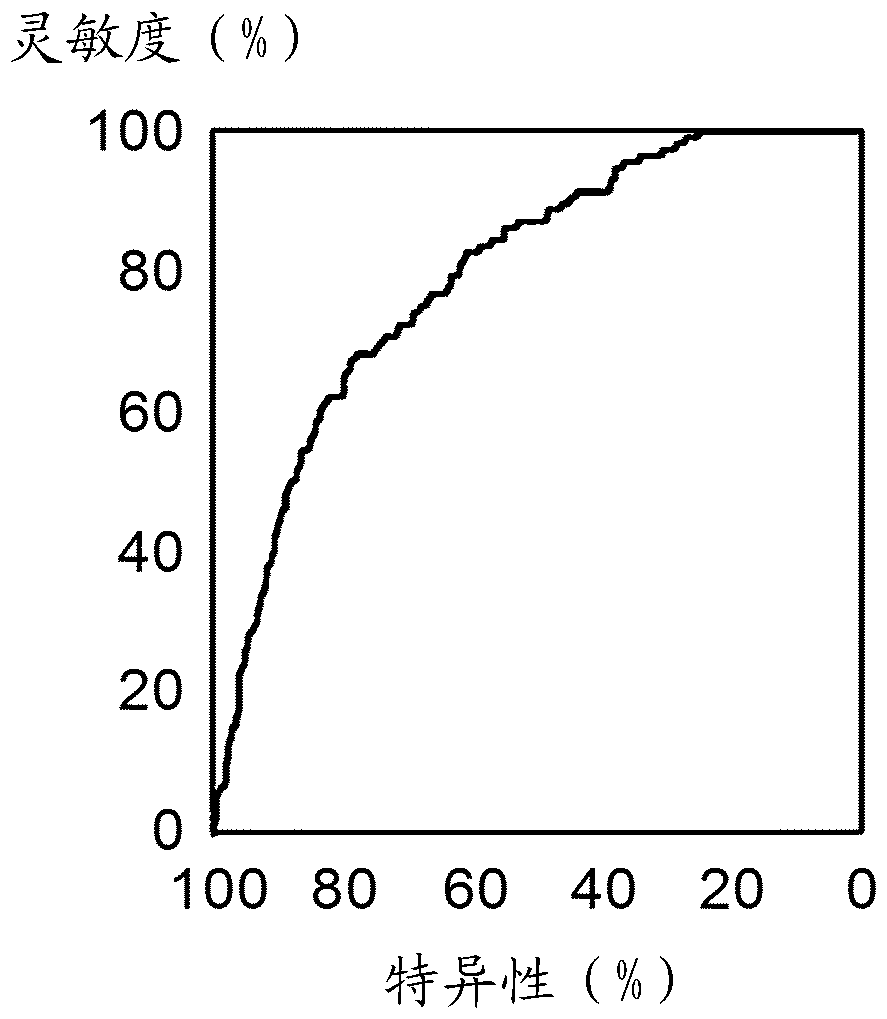Combination test for colorectal cancer
A technology for colorectal cancer and colorectal adenoma, which is applied in the field of detection and screening, and can solve the problems of increased mortality and decreased number of CRC
- Summary
- Abstract
- Description
- Claims
- Application Information
AI Technical Summary
Problems solved by technology
Method used
Image
Examples
Embodiment 1
[0235]1907 people who tested positive in the FIT (fecal occult blood) test and were referred for colonoscopy for this reason gave informed consent to provide blood samples and to use patient data anonymously. Blood samples were collected prior to colonoscopy and analyzed using assays for cell-free nucleosomes, including nucleosomes themselves and DNA containing 5-methylcytosine modifications, the histone variants H2AZ and mH2A1. 1. Histone modifications pH2AX, H2AK119Ub, H3K36Me3, H4K20Me3, H4PanAc, and H3S10Ph, and nucleosomes with epigenetic characteristics of the nucleosome adduct nucleosome-HMGB1 and nucleosome-EZH2.
[0236] All of these nucleosome assays can be used in the methods of the invention. Results from a panel involving 5 nucleosome assays (5-methylcytosine, H2AK119Ub, pH2AX, H3K36Me3, and nucleosome-HMGB1 adduct) together with human numerical FIT levels and age are presented in figure 1 Shown in the ROC curve in , the results were used to discriminate CRC case...
Embodiment 2
[0238] 1907 individuals who tested positive in the FIT (fecal occult blood) test and were referred for colonoscopy for this reason gave informed consent for the use of patient data anonymously. For each individual, enter their fecal hemoglobin (Hb) level (in μgHb / g feces) and patient age (in years) into the expression:
[0239] 0.0129 x FIT level (µg Hb / g feces) + 0.0688 x age (years)
[0240] If the output value of the expression is greater than 4.8, the patient is designated as high risk for CRC and requires colonoscopy. Correspondingly, if the output value of the expression is less than 4.8, the patient is designated as low risk for CRC and does not require colonoscopy.
[0241] Of 118 diagnosed CRC cases, 114 were correctly designated as requiring colonoscopy using this method. Similarly, 222 (88.1%) of 252 high-risk adenoma cases were correctly designated as requiring colonoscopy. The ROC curve showed that at a specificity of 25%, the sensitivity of the method for CRC ...
Embodiment 3
[0243] 599 people who tested positive in the FIT (fecal occult blood) test and were referred for colonoscopy for this reason gave informed consent to provide blood samples and to use patient data anonymously. Blood samples were collected prior to colonoscopy and analyzed for ferritin and CEA. Enter the result of the measure combined with the patient's age and the numeric FIT result into the expression:
[0244] 0.51 x age(years) + 0.17 x CEA (ng / ml) - 17.85 x (5xFIT) -0.1 (µg Hb / g feces) -0.17 x transferrin (ng / ml)
[0245] This expression was set to reduce colonoscopy referrals by 25%. If the output value of the expression is greater than −8.6, the patient is designated as high risk for CRC and requires colonoscopy. Correspondingly, if the expressed output value is less than −8.6, the patient is designated as low risk for CRC and does not require colonoscopy. Of 118 diagnosed CRC cases, 116 were correctly assigned as requiring colonoscopy using this method of the present...
PUM
| Property | Measurement | Unit |
|---|---|---|
| Sensitivity | aaaaa | aaaaa |
Abstract
Description
Claims
Application Information
 Login to View More
Login to View More - R&D
- Intellectual Property
- Life Sciences
- Materials
- Tech Scout
- Unparalleled Data Quality
- Higher Quality Content
- 60% Fewer Hallucinations
Browse by: Latest US Patents, China's latest patents, Technical Efficacy Thesaurus, Application Domain, Technology Topic, Popular Technical Reports.
© 2025 PatSnap. All rights reserved.Legal|Privacy policy|Modern Slavery Act Transparency Statement|Sitemap|About US| Contact US: help@patsnap.com


